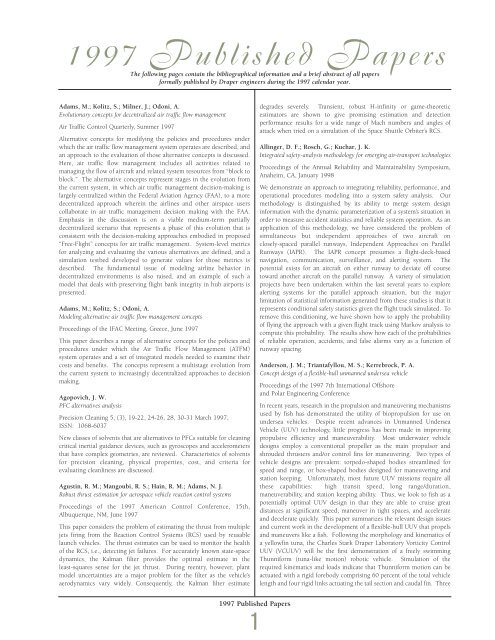1998 - Draper Laboratory
1998 - Draper Laboratory
1998 - Draper Laboratory
- No tags were found...
Create successful ePaper yourself
Turn your PDF publications into a flip-book with our unique Google optimized e-Paper software.
1997 Published PapersThe following pages contain the bibliographical information and a brief abstract of all papersformally published by <strong>Draper</strong> engineers during the 1997 calendar year.Adams, M.; Kolitz, S.; Milner, J.; Odoni, A.Evolutionary concepts for decentralized air traffic flow managementAir Traffic Control Quarterly, Summer 1997Alternative concepts for modifying the policies and procedures underwhich the air traffic flow management system operates are described, andan approach to the evaluation of those alternative concepts is discussed.Here, air traffic flow management includes all activities related tomanaging the flow of aircraft and related system resources from “block toblock.” The alternative concepts represent stages in the evolution fromthe current system, in which air traffic management decision-making islargely centralized within the Federal Aviation Agency (FAA), to a moredecentralized approach wherein the airlines and other airspace userscollaborate in air traffic management decision making with the FAA.Emphasis in the discussion is on a viable medium-term partiallydecentralized scenario that represents a phase of this evolution that isconsistent with the decision-making approaches embodied in proposed“Free-Flight” concepts for air traffic management. System-level metricsfor analyzing and evaluating the various alternatives are defined, and asimulation testbed developed to generate values for those metrics isdescribed. The fundamental issue of modeling airline behavior indecentralized environments is also raised, and an example of such amodel that deals with preserving flight bank integrity in hub airports ispresented.Adams, M.; Kolitz, S.; Odoni, A.Modeling alternative air traffic flow management conceptsProceedings of the IFAC Meeting, Greece, June 1997This paper describes a range of alternative concepts for the policies andprocedures under which the Air Traffic Flow Management (ATFM)system operates and a set of integrated models needed to examine theircosts and benefits. The concepts represent a multistage evolution fromthe current system to increasingly decentralized approaches to decisionmaking.Agopovich, J. W.PFC alternatives analysisPrecision Cleaning 5, (3), 19-22, 24-26, 28, 30-31 March 1997,ISSN: 1068-6037New classes of solvents that are alternatives to PFCs suitable for cleaningcritical inertial guidance devices, such as gyroscopes and accelerometersthat have complex geometries, are reviewed. Characteristics of solventsfor precision cleaning, physical properties, cost, and criteria forevaluating cleanliness are discussed.Agustin, R. M.; Mangoubi, R. S.; Hain, R. M.; Adams, N. J.Robust thrust estimation for aerospace vehicle reaction control systemsProceedings of the 1997 American Control Conference, 15th,Albuquerque, NM, June 1997This paper considers the problem of estimating the thrust from multiplejets firing from the Reaction Control Systems (RCS) used by reusablelaunch vehicles. The thrust estimates can be used to monitor the healthof the RCS, i.e., detecting jet failures. For accurately known state-spacedynamics, the Kalman filter provides the optimal estimate in theleast-squares sense for the jet thrust. During reentry, however, plantmodel uncertainties are a major problem for the filter as the vehicle’saerodynamics vary widely. Consequently, the Kalman filter estimatedegrades severely. Transient, robust H-infinity or game-theoreticestimators are shown to give promising estimation and detectionperformance results for a wide range of Mach numbers and angles ofattack when tried on a simulation of the Space Shuttle Orbiter’s RCS.Allinger, D. F.; Rosch, G.; Kuchar, J. K.Integrated safety-analysis methodology for emerging air-transport technologiesProceedings of the Annual Reliability and Maintainability Symposium,Anaheim, CA, January <strong>1998</strong>We demonstrate an approach to integrating reliability, performance, andoperational procedures modeling into a system safety analysis. Ourmethodology is distinguished by its ability to merge system designinformation with the dynamic parameterization of a system’s situation inorder to measure accident statistics and reliable system operation. As anapplication of this methodology, we have considered the problem ofsimultaneous but independent approaches of two aircraft onclosely-spaced parallel runways, Independent Approaches on ParallelRunways (IAPR). The IAPR concept presumes a flight-deck-basednavigation, communication, surveillance, and alerting system. Thepotential exists for an aircraft on either runway to deviate off coursetoward another aircraft on the parallel runway. A variety of simulationprojects have been undertaken within the last several years to explorealerting systems for the parallel approach situation, but the majorlimitation of statistical information generated from these studies is that itrepresents conditional safety statistics given the flight track simulated. Toremove this conditioning, we have shown how to apply the probabilityof flying the approach with a given flight track using Markov analysis tocompute this probability. The results show how each of the probabilitiesof reliable operation, accidents, and false alarms vary as a function ofrunway spacing.Anderson, J. M.; Triantafyllou, M. S.; Kerrebrock, P. A.Concept design of a flexible-hull unmanned undersea vehicleProceedings of the 1997 7th International Offshoreand Polar Engineering ConferenceIn recent years, research in the propulsion and maneuvering mechanismsused by fish has demonstrated the utility of biopropulsion for use onundersea vehicles. Despite recent advances in Unmanned UnderseaVehicle (UUV) technology, little progress has been made in improvingpropulsive efficiency and maneuverability. Most underwater vehicledesigns employ a conventional propeller as the main propulsor andshrouded thrusters and/or control fins for maneuvering. Two types ofvehicle designs are prevalent: torpedo-shaped bodies streamlined forspeed and range, or box-shaped bodies designed for maneuvering andstation keeping. Unfortunately, most future UUV missions require allthese capabilities: high transit speed, long range/duration,maneuverability, and station keeping ability. Thus, we look to fish as apotentially optimal UUV design in that they are able to cruise greatdistances at significant speed, maneuver in tight spaces, and accelerateand decelerate quickly. This paper summarizes the relevant design issuesand current work in the development of a flexible-hull UUV that propelsand maneuvers like a fish. Following the morphology and kinematics ofa yellowfin tuna, the Charles Stark <strong>Draper</strong> <strong>Laboratory</strong> Vorticity ControlUUV (VCUUV) will be the first demonstration of a freely swimmingThunniform (tuna-like motion) robotic vehicle. Simulation of therequired kinematics and loads indicate that Thunniform motion can beactuated with a rigid forebody comprising 60 percent of the total vehiclelength and four rigid links actuating the tail section and caudal fin. Three1997 Published Papers1
















